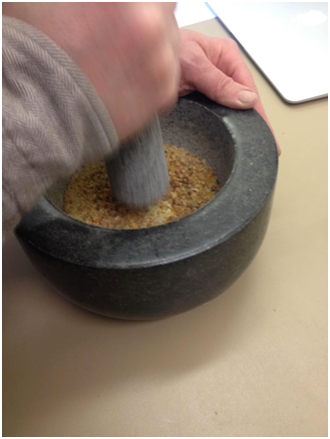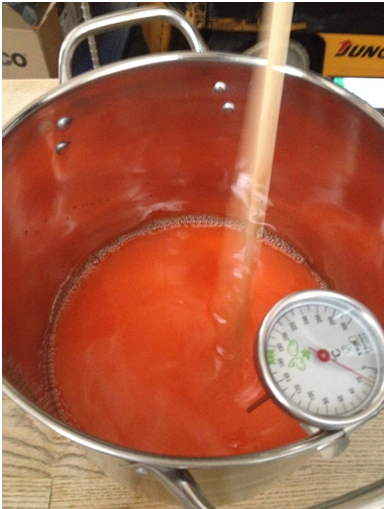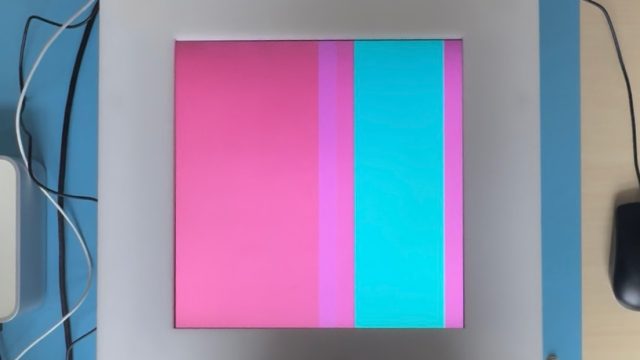This post was written by History of Design MA students taking part in the course’s ‘Thinking and Experiencing Techne’ seminar/lab class.
Katie Vann, Melissa Tyler and Rebecca Goozee reflect on their experience of interpreting a varnish recipe from a sixteenth-century French manuscript, now in the Bibliothèque Nationale in Paris:
The recipe presented us with various challenges as it is quite vague and very brief:
‘The Germans boil the minium intensely in linseed oil, and to give it the consistency of varnish, they mix in heavily pulverized amber’.
After our initial experience using copal instead of amber, our group was keen to follow the recipe as literally as possible this time. We mixed linseed oil with pulverised amber (thanks to our tutors, who tracked down a kilogram of amber online, which was speedily delivered from Lithuania!) One challenge is that the recipe omits to say exactly how and when to add the amber or minium (also known as ‘red lead’). This might have been self-evident to some sixteenth-century artisans, but in our case we had to experiment with different methods. Our group chose to heat the linseed oil first and then slowly add the amber, which we had finely pulverised.

We relied heavily on the practical knowledge that we gained from our previous lab experience in this class to guide us. This included an understanding of the material properties of linseed oil – specifically, a sense of when it was ‘ready’ by recognizing the different stages of smells, from nutty to acrid, as it heats. The experiment was not wholly successful (we could not get the amber hot enough to melt and combine with the other ingredients properly, possibly because our ‘lab’ is outside and vulnerable to winter breezes and possibly because the amber had not been ground finely enough). However, we did learn that judging a recipe based on smell, sight and sound was as important as trying to follow a manuscript exactly.
This experiment brought up an interesting question for us concerning the ‘scientific’ nature of our explorations. We have observed that our experiments are – by their very nature – semi-scientific. Throughout the process, we have changed or had to make possibly arbitrary decisions in terms of some of the parameters used (such as timing and ingredients) too much for the experiments to be considered otherwise. A more strictly scientific process might not leave room for decisions based on sensation and immediate judgments, which these recipes seem to necessitate. We had to make judgements throughout the process about how to produce the varnishes successfully by using our senses and also relying on tacit knowledge that we had gained through our previous experiments on this course.
Students Maria Simoes Coelho and Tanya Bentley add:
Our group experimented with a different interpretation of the same recipe, adding the minium to the linseed oil at the start and then heating. The linseed oil immediately changed colour from a rich dark yellow to a bright, almost fluorescent, orange. It took a while for the mixture to fully blend and it was only when the liquid took on a brilliant jewel-like tone of dark orange that we understood that it was fully incorporated and that we could proceed to the next part of the recipe: adding the pulverized amber. As the recipe does not specify when to mix in the amber, we experimented with a different procedure. Instead of adding the amber after the other ingredients had boiled, we added it to the mixture before it reached the boiling point at which the amber was most likely to melt. This resulted in a much darker, sludgier mixture.

By the end, our group felt this method was not a viable way to follow the recipe, concluding that the linseed oil had to be heated before adding the minium and amber. This made us realise that the kind of tacit, often-unspoken knowledge about the process and materials that an experienced artisan would have about varnishes was key to fully grasping this seemingly straightforward task. But we did start to gain a kind of material knowledge. The overall experience was highly sensorial. Our decisions were primarily made based on visual, haptic and olfactory cues: colour, texture, smoke as well as changing smells all played a part in our understanding of how to react to the process occurring before our eyes.
Click here for the previous blog from the ‘Techne’ seminar/lab series.
To see what else V&A/RCA History of Design students have been up to, read our other blog posts, check our pages on the RCA website and take a look at Un-Making Things, a student-run online platform for all things design history and material culture.


